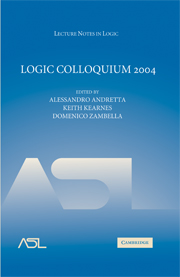Book contents
- Frontmatter
- Contents
- Introduction
- Speakers and Titles
- Abstract elementary classes: some answers, more questions
- On the density of Hausdorff ultrafilters
- Zero-groups and maximal tori
- Constructive set theory with operations
- Parametrized local zeta functions
- Colourings of hypergraphs, permutation groups and CSP's
- Tolerance intersection properties and subalgebras of squares
- Universes in type theory part I—Inaccessibles and Mahlo
- Hausdorff-dimension and weak truth-table reducibility
- Computation and the explanation of intelligent behaviours: ethologically motivated restart
- Constructible sheaves and definability
- An overview of modern universal algebra
- Lecture Notes in Logic
Colourings of hypergraphs, permutation groups and CSP's
Published online by Cambridge University Press: 05 July 2014
- Frontmatter
- Contents
- Introduction
- Speakers and Titles
- Abstract elementary classes: some answers, more questions
- On the density of Hausdorff ultrafilters
- Zero-groups and maximal tori
- Constructive set theory with operations
- Parametrized local zeta functions
- Colourings of hypergraphs, permutation groups and CSP's
- Tolerance intersection properties and subalgebras of squares
- Universes in type theory part I—Inaccessibles and Mahlo
- Hausdorff-dimension and weak truth-table reducibility
- Computation and the explanation of intelligent behaviours: ethologically motivated restart
- Constructible sheaves and definability
- An overview of modern universal algebra
- Lecture Notes in Logic
Summary
Abstract. We investigate the complexity of strong colouring problems of hypergraphs associated to groups of permutations initiated in [13]. By reformulating these as Constraint Satisfaction Problems (CSP's) we are able to exploit recent algebraic results to answer various questions posed by Haddad and Rödl [13]. In particular, we show that all known tractable cases are explained by the presence of a Mal'tsev operation, and that all known NP-complete cases correspond to algebras that admit no Taylor operation, thus confirming the dichotomy conjecture by Bulatov et al. [7, 8]. We classify completely the case where the group consists of all affine transformations on a ring of matrices over a commutative ring.
Introduction. We start by briefly describing the strong colouring problem for permutation groups that was investigated in [13] and [12]; this problem has its origins in the classification of maximal partial clones over a finite non-empty set [14, 15, 16]. We shall immediately reformulate this decision problem as a Constraint Satisfaction Problem (CSP) in order to exploit various universal algebraic tools to study its algorithmic complexity.
Information
- Type
- Chapter
- Information
- Logic Colloquium 2004 , pp. 93 - 108Publisher: Cambridge University PressPrint publication year: 2007
